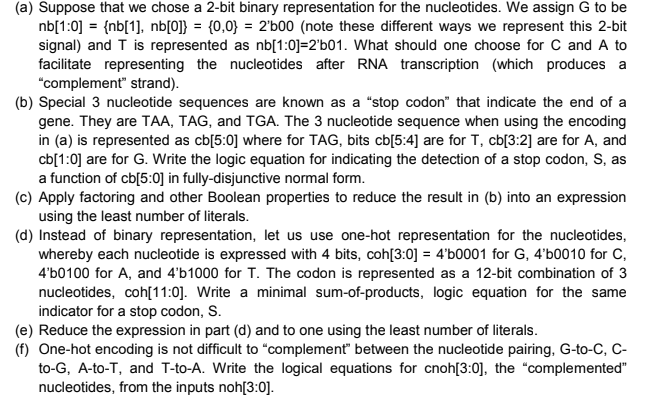Answered step by step
Verified Expert Solution
Question
1 Approved Answer
Answers only needed for b) through e) Recall that a DNA is composed of 4 different nucleotides, G, C, A, and T (or U), grouped


Answers only needed for b) through e)
Recall that a DNA is composed of 4 different nucleotides, G, C, A, and T (or U), grouped as 2 pairs (G with C, and A with T). The complementary pairing facilitates transcription of DNA into RNA. Three nucleotides in sequence are recognized as distinct amino acids. For instance, GGG correspond to glycine. (a) Suppose that we chose a 2-bit binary representation for the nucleotides. We assign G to be nb[1:0] = {nb[1], nb[0]} = {0,0) = 2'b00 (note these different ways we represent this 2-bit signal) and T is represented as nb(1:0)=2'b01. What should one choose for C and A to facilitate representing the nucleotides after RNA transcription (which produces a "complement strand). (b) Special 3 nucleotide sequences are known as a "stop codon" that indicate the end of a gene. They are TAA, TAG, and TGA. The 3 nucleotide sequence when using the encoding in (a) is represented as cb[5:0] where for TAG, bits cb[5:4) are for T, cb[3:2] are for A, and cb[1:0) are for G. Write the logic equation for indicating the detection of a stop codon, S, as a function of cb[5:0] in fully-disjunctive normal form. (c) Apply factoring and other Boolean properties to reduce the result in (b) into an expression using the least number of literals. (d) Instead of binary representation, let us use one-hot representation for the nucleotides, whereby each nucleotide is expressed with 4 bits, coh[3:0) = 4'b0001 for G, 4'60010 for C, 4'b0100 for A, and 4'b1000 for T. The codon is represented as a 12-bit combination of 3 nucleotides, coh[11:0). Write a minimal sum-of-products, logic equation for the same indicator for a stop codon, S. (e) Reduce the expression in part (d) and to one using the least number of literals. (f) One-hot encoding is not difficult to "complement between the nucleotide pairing, G-to-C, C- to-G, A-to-T, and T-to-A. Write the logical equations for cnoh[3:0), the "complemented" nucleotides, from the inputs noh[3:0). Recall that a DNA is composed of 4 different nucleotides, G, C, A, and T (or U), grouped as 2 pairs (G with C, and A with T). The complementary pairing facilitates transcription of DNA into RNA. Three nucleotides in sequence are recognized as distinct amino acids. For instance, GGG correspond to glycine. (a) Suppose that we chose a 2-bit binary representation for the nucleotides. We assign G to be nb[1:0] = {nb[1], nb[0]} = {0,0) = 2'b00 (note these different ways we represent this 2-bit signal) and T is represented as nb(1:0)=2'b01. What should one choose for C and A to facilitate representing the nucleotides after RNA transcription (which produces a "complement strand). (b) Special 3 nucleotide sequences are known as a "stop codon" that indicate the end of a gene. They are TAA, TAG, and TGA. The 3 nucleotide sequence when using the encoding in (a) is represented as cb[5:0] where for TAG, bits cb[5:4) are for T, cb[3:2] are for A, and cb[1:0) are for G. Write the logic equation for indicating the detection of a stop codon, S, as a function of cb[5:0] in fully-disjunctive normal form. (c) Apply factoring and other Boolean properties to reduce the result in (b) into an expression using the least number of literals. (d) Instead of binary representation, let us use one-hot representation for the nucleotides, whereby each nucleotide is expressed with 4 bits, coh[3:0) = 4'b0001 for G, 4'60010 for C, 4'b0100 for A, and 4'b1000 for T. The codon is represented as a 12-bit combination of 3 nucleotides, coh[11:0). Write a minimal sum-of-products, logic equation for the same indicator for a stop codon, S. (e) Reduce the expression in part (d) and to one using the least number of literals. (f) One-hot encoding is not difficult to "complement between the nucleotide pairing, G-to-C, C- to-G, A-to-T, and T-to-A. Write the logical equations for cnoh[3:0), the "complemented" nucleotides, from the inputs noh[3:0)Step by Step Solution
There are 3 Steps involved in it
Step: 1

Get Instant Access to Expert-Tailored Solutions
See step-by-step solutions with expert insights and AI powered tools for academic success
Step: 2

Step: 3

Ace Your Homework with AI
Get the answers you need in no time with our AI-driven, step-by-step assistance
Get Started


